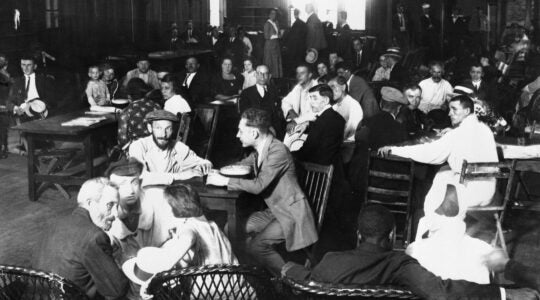NEW YORK (JTA) — A recent JTA article by Amy Klein, “Are Jewish Boys in Crisis?,” raises some troubling questions. The article reviews research suggesting that boys are less resilient and ambitious than in decades past.
Klein, who explores whether this is true for Jews, correctly suggests that Jewish boys are probably no worse off than other teenage boys and perhaps have more extensive support networks. The article subsequently explores the “crisis” afflicting boys in Jewish education, and asks why Jewish boys are more likely to drop out of Jewish educational programs than Jewish girls.
This is where the answers get tricky and where the impact of gender really emerges.
Klein paraphrases one prominent Jewish psychologist, Wendy Mogel, who suggests that “religious life has opportunities more natural to Jewish girls, like tending to younger kids and teaching them, and socializing, while boys prefer more dangerous and risky activities.”
Are these really natural, biological impulses or a reflection of the way in which boys and girls are socialized to behave by adults?
The corpus of feminist developmental research that has emerged over the past 40 years presents significant challenges to Mogel’s biological argument. The argument also presumes a narrowly defined Jewish educational standard in which true religious life is relegated to a particular sphere of activities — a sphere that is subsequently gendered as female.
Thus the participation of boys in Jewish life becomes a self-fulfilling prophesy: We teach kids what is considered acceptable behavior for boys and girls, then act surprised when they follow the gendered paths we have laid.
No one should be surprised that Jewish boys and girls avoid or drop out of most Jewish educational programs. Jewish education is almost always based upon the needs and desires of adults rather than kids. Adult fears about assimilation, anti-Semitism and intermarriage lead to programs designed and funded by adults that impose rigid definitions of Jewish identity and learning on kids.
Adult fears about Jewish continuity also lead to the misguided notion that Jewish learning can only happen in exclusively Jewish environments. Approximately 85 percent to 90 percent of Jewish teenagers attend non-Jewish public and private schools and therefore have non-Jewish friends. Everything we know about adolescent psychology tells us that teens do not want to be isolated from their friends.
So why do we think that isolationist, exclusionary programs are going to speak to this generation of Jewish teens?
The Curriculum Initiative, which supports Jewish culture and identity at independent high schools, once believed that running Jewish-only programs spearheaded by our educators was the only authentic way to educate Jewish kids. Consequently, our student participation rate was underwhelming.
The moment we opened our programs to Jewish students, friends and allies, asked kids about their intellectual and social interests, and collaboratively created Jewish educational programs with our students, our numbers of regular Jewish participants soared.
More importantly, the percentage of these participants who were not affiliated with Jewish institutions like synagogues, youth groups and Jewish camps far surpassed the number of “affiliated” participants.
The reality is that the overwhelming majority of Jewish kids and families live in a multicultural world. Isolationism, a fervently Orthodox response to modernity, has been rejected by the majority of American Jews in all but one arena: Jewish education.
Most American Jews choose to live, work and play in multicultural communities, but when it comes to teaching our children, fear governs Jewish content and practice. We try to rip kids out of their environments and herd them into the closed walls of our institutions rather than meeting them where they are physically, intellectually, emotionally and socially.
The message that this sends is that a fundamental rift exists between their Jewish selves and the rest of who they are and what they experience. This dichotomy is false. The Jewish students I meet realize that identity is fluid, and that this fluidity does not “dilute” their Jewishness.” Rather, it acknowledges our human complexity.
Jewish learning should be similarly complex in order to help teenagers make sense of the complex world in which they live. When The Curriculum Initiative asked Jewish students at a boarding school for their ideas on crafting a campus Passover seder, students responded by including the campus Gay-Straight Alliance in the program because they felt that the ancient Jewish experience of liberation resonated with their sense of contemporary social justice for gays and lesbians.
Jewish boys and girls are in crisis only to the extent that they hold a mirror to Jewish adults. Until we are self-reflective about our inability — and the inability of our institutions — to meaningfully apply Jewish learning to the lived experiences of teens, we will never keep them interested in Jewish education.
(Adam Gaynor is the executive director of The Curriculum Initiative.)





